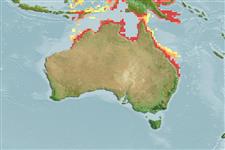Common names from other countries
>
Carangaria/misc (Various families in series Carangaria) >
Polynemidae (Threadfins)
Etymology: Polydactylus: Greek, poly = a lot of + greek, daktylos = finger (Ref. 45335).
More on author: Günther.
Environment: milieu / climate zone / depth range / distribution range
Ecologia
marino; acqua dolce; salmastro demersale; catadromo (Ref. 51243); distribuzione batimetrica 0 - 6 m (Ref. 57343). Tropical; 5°S - 28°S, 121°E - 154°E (Ref. 57343)
Indo-West Pacific: southern New Guinea and northern Australia.
Size / Peso / Age
Maturity: Lm ? range ? - ? cm
Max length : 170 cm FL maschio/sesso non determinato; (Ref. 6390); common length : 48.0 cm FL maschio/sesso non determinato; (Ref. 9685); peso massimo pubblicato: 45.0 kg (Ref. 9685); Età massima riportata: 20 anni (Ref. 6390)
Short description
Morfologia | Morfometria
Body without spots nor stripes. Pectoral fin rays unbranched; 4th pectoral filament long, 40-53% of SL. Second spine of dorsal fin more robust than the rest. Posterior margin of maxilla extending considerably beyond level of posterior margin of adipose eyelid. Lower tip of 7th proximal pterygiophore of 1st dorsal fin directed backward. Lateral squamation on caudal fin unbranched (Ref. 40970).
Found in shallow, turbid waters coastal waters, estuaries, mangrove creeks, and mangrove-lined rivers (Ref. 57343), over sandbanks and mud substrates (Ref. 6390). Usually forms loose schools, although larger fish are more often observed in pairs or singly (Ref. 6390). Feeds on prawns and fish. Protandrous hermaphrodites.
Life cycle and mating behavior
Maturità | Riproduzione | Deposizione | Uova | Fecundity | Larve
King threadfin between 70 cm and 100 cm FL may be transitional hermaphrodites (they possess mature male and immature female reproductive tissue, and function as males (Ref. 28736)). However, most king threadfin less than 80 cm FL are males and most more than 95 cm FL are females (Ref. 28737). Transitional king threadfin are most often found in the months of June, July, August and September (Ref. 6390).
There is little information on the larvae, although nursery areas are known to be inshore, shallow and of low salinity (Ref. 6390).
Motomura, H., 2004. Threadfins of the world (Family Polynemidae). An annotated and illustrated catalogue of polynemid species known to date. FAO Spec. Cat. Fish. Purp. Rome: FAO. 3:117 p. (Ref. 57343)
IUCN Red List Status (Ref. 130435)
CITES (Ref. 128078)
Not Evaluated
Threat to humans
Harmless
Human uses
Pesca: commerciale; Pesce da pesca sportiva: si
Informazioni ulteriori
BibliografiaAcquacolturaProfilo di acquacolturaVarietàGeneticaElectrophoresesEreditarietàMalattieElaborazioneMass conversion
CollaboratoriImmaginiStamps, Coins Misc.SuoniCiguateraVelocitàModalità di nuotoArea branchialeOtolithsCervelliVista
Strumenti
Special reports
Download XML
Fonti Internet
Estimates based on models
Preferred temperature (Ref.
115969): 24.8 - 28.9, mean 28 (based on 575 cells).
Phylogenetic diversity index (Ref.
82804): PD
50 = 0.5000 [Uniqueness, from 0.5 = low to 2.0 = high].
Bayesian length-weight: a=0.00676 (0.00311 - 0.01469), b=3.10 (2.93 - 3.27), in cm Total Length, based on LWR estimates for this Genus-body shape (Ref.
93245).
Trophic level (Ref.
69278): 4.0 ±0.4 se; based on diet studies.
Resilienza (Ref.
120179): Basso, tempo minimo di raddoppiamento della popolazione 4.5 - 14 anni (tmax=20).
Fishing Vulnerability (Ref.
59153): High to very high vulnerability (66 of 100).
